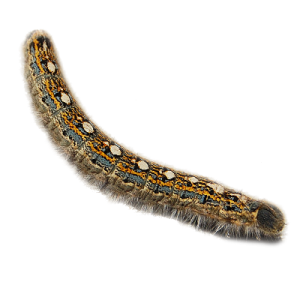QUESTION: Why are there so many caterpillars on my tress and how can I get rid of them?
ANSWER: All across western Canada we are seeing outbreak levels of Forest Tent Caterpillars. These caterpillars emerge from their egg sacs in May and turn into large golden brown moths in July. The adult female moths lay their eggs on twigs and branches and the Forest Tent Caterpillar lifecycle repeats. As the years go by, these caterpillars naturally increase in number to where their lifecycle creates numerous individual larvae. As each egg sac contains approximately 150 eggs, it takes roughly 10 – 15 years for Forest Tent Caterpillar numbers to explode. Currently we are likely in the second year of the 1 – 3 year outbreak cycle and it’s very likely that we will see even more of these Forest Tent Caterpillars next year.
The lifecycle of the Forest Tent Caterpillar is seen in these four stages:
- Egg – Adult female moths lay their eggs on branches and twigs in July. Each grey-black egg sac (which resembles a small piece of poop) holds around 150 eggs. The egg sac remains on the tree through fall and winter until early May of the following year.
- Larva – Once the eggs hatch, newly emerged caterpillars feed on the foliage of susceptible trees. In large numbers they can defoliate the trees causing them to be stressed and possibly more attractive to other tree diseases and pests. The larvae live for approximately 4 – 6 weeks going through five instars of growth.
- Pupa – In early to mid-June these caterpillars create cocoons in which they remain in for approximately six weeks.
- Adult – Forest Tent Caterpillars will emerge from their cocoons as large golden brown moths. The adult moths will live for several weeks and females will lay eggs on branches and twigs.
The Forest Tent Caterpillar outbreak is usually stopped by either a natural crash of the population by the introduction of a parasite or disease in the Forest Tent Caterpillar group. This crashes the population and it takes 10 – 15 years to recover.
These caterpillars feed on the leaves of trees during the night and can cause defoliation. During the day, the larvae clump together to protect themselves from predators and to sun themselves to keep warm. Because Forest Tent Caterpillar’s feed at night, controlling them is easy during the day.
There are FOUR SIMPLE SOLUTIONS you can use to prevent damage to your trees:
- Contact Insecticide – Spray during the day with a pyrethroid with PBO or a permethrin. Direct kill of the larvae and using an environmentally friendly option. Products like Dr. Doom; Bio-mist; or Bug-X will do the trick.
- Malathion – Use with contact insecticide or other contact orangophosphate.
- Microbial Insecticide – like BTK, but note as the larvae get older they need to ingest the bacteria; the level of control may be minimal. If they were sprayed earlier in May then proper control is achieved.
- Broom, Stick, or Scraper – Good old fashioned way of a broom, a stick, or a scraper used during the day to get rid of the clumps of larvae. Collect the caterpillars in a garbage bag and dispose.
If you want more information please contact Poulin’s Pest Control to discuss options for protecting your trees. Our experts can tell you all there is to know about Forest Tent Caterpillars and provide you with the best advice on how to deal with this pest.

